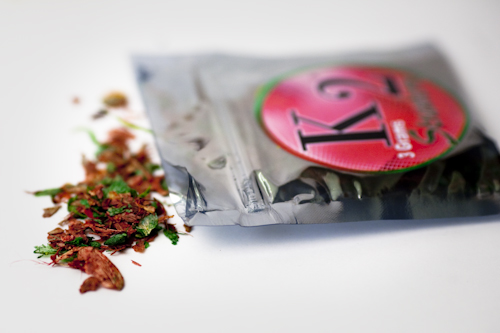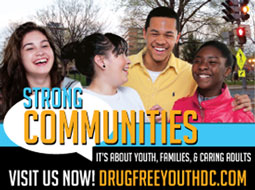Posted by Andrew Giambrone on July 23, 2015 at 11:10 am

A mural depicting Martin Luther King Jr. and Rosa Parks watches over the space. A tree in the middle provides shade to pedestrians, who might grab a bike from the Capital Bikeshare station on the other side. Thereâs a fountain, too, but because it hasnât run in months, itâs completely dried up.
Starburst Plazaâa public space at the intersection of four major streets in Northeastâalso goes by a different name among people in the area: âScooby Park,â so called for a popular type of synthetic marijuana, Scooby Snax. (It comes packaged in “potpourri” pouches bearing the cartoon dogâs image.)
Residents, community leaders, and District officials say the plaza has become a hub not just for bus stops and benches but also for alcohol consumption and the synthetic-drug activity plaguing D.C. Named for the âstarburstâ pattern created by the union of H Street, Maryland Avenue, and Bladensburg and Benning roads NE, the plaza is administered by the District Department of Transportation and maintained by H Street Main Street, a nonprofit.
âFrom where it used to be, H Street is good,â says Tammi Mack, a site supervisor for H Street Main Street, which helps clean the corridor. âBut that jointâÂâStarburst PlazaÂââis rough.â
Just last Thursday, D.C. police officers arrested two people suspected of selling synthetic drugs in the park. The arrests followed the forced closings of two storesâone in Bloomingdale, the other near the plaza, in Carver Langstonâalso for allegedly selling the stuff. Such enforcement is part of a broader crackdown on the drugs after an uptick in overdose-hospitalizations and other incidents; the city recently passed emergency legislation allowing agencies to shut down stores for selling.
Health officials say synthetic drugs are dangerous becauseâwhile mimicking the effects of LSD, ecstasy, and cocaineâtheir use can lead to violent behavior, seizures, and self-harm. Officials have expressed concern that the drugs more closely resemble PCP than pot. On July 4, 18-year-old Jasper Spires allegedly stabbed 24-year-old Kevin Sutherland on Metroâs Red Line, killing him; police believe Spires was high on synthetic drugs. A few days later, a woman who police said had been smoking synthetic marijuana left a baby on a busy street. Earlier this month, Police Chief Cathy Lanier suggested the drugs could push D.C. back â20 years.â
At Starburst Plaza, the situation is challenging. Adam Roberts, a commissioner for ANC 5D, says that the intersectionâs design invites “loitering.” While the spaceâs design encourages pedestrians to frequent the plaza, itâs also ideal for drug exchanges: Multiple entry points make it easy for people to come and go; the placement of its chess tablesâin front of the defunct fountain at a remove from the streetâmakes it hard for onlookers to see beyond huddled groups of people. On average, between 30 and 50 people gather in the space, Roberts says. Many are just hanging out; others may be participating in drug deals or getting intoxicated.
âIt is very hard to differentiate between legal and illegal activity,â Roberts says. âThatâs part of the fear about the plaza. People are afraid of it because they donât know whatâs going on.â
Metropolitan Police Department spokeswoman Gwendolyn Crump wrote in an email that the police have seen âan increase in the presence and use of synthetic drugs more recentlyâ near Starburst Plaza, and that the departmentâs narcotics unit made 29 arrests on the street citywide from June 19 to July 15. âWe are aware of the challenges in this area and we are working to address them,â Crump wrote, citing a walk-through that MPDâs Assistant Chief Diane Groomes and Fifth District Commander William Fitzgerald participated in with Deputy Mayor Kevin Donahue and others along the Benning Road corridor on July 17. âThe city government and the community will need to continue to work together to rid the District of this dangerous drug,â Crump explained. âAs usual, it takes a village.â
According to a National Capital Planning Commission memo, DDOT approved Starburst Plazaâs construction in 2005 as a way to help âstreamline vehicle traffic, buffer pedestrians from it, and improve actual and perceived pedestrian safety.â Starburstâs mural was meant to become a âvisible landmark, which will contribute to the revitalization and economic growth of this area.â
Anwar Saleem hopes to change the problems with the plaza. As the executive director of H Street Main Street since 2007, heâs often talked to the people who hang around Starburst Plaza. Saleem tells me he once met a young woman named Kamara there who had been using K2, also known as âspice.â When she opened her mouth, Saleem says, her gums and teeth looked black, âlike something out of The Night of the Living Dead.â Other times, heâs seen people seemingly âzombied outâ on K2.
âThe city should feel really embarrassed,â Saleem contends. âThe churches and religious institutions, the social-service organizations should feel embarrassed. If they do anything, they should take that embarrassment and make change to help people instead of just dispersing them.â
On July 10, the District issued Saleemâs organization a permit to maintain the plaza and to enrich the space with âentertainment venues and markets.â One of those enrichments has been a Twilight Farmers Market hosted on Thursdays from 3 to 7 p.m. The market features over 10 local vendors offering fresh produce, meats, and baked goods. So far, it seems to be off to a good start: Roberts, the ANC commissioner, says he hasnât seen any incidents between vendors and the people on plaza. âWeâre starting to see what Starburst could be if itâs taken care of,â he adds. âRight now, though, itâs arguably one of the most blighted parts of D.C.â
Saleem says H Street Main Street will soon start to host other programs at the plaza, such as a retail craft market, rotating art exhibitions, and nighttime dancing. But for all its benefits to the community, programming alone canât solve the drug and alcohol problems at Starburst, he admits: Maintaining an effective police presence in the area and increasing access to social services like job-training programs, mental-health counseling, and affordable housing will be necessary to eradicate the root causes of the issuesâpoverty, homelessness, and unemployment.
âWe have nothing but great expectations for the future of the plaza and the future of H Street,â says DDOT Deputy Associate Director Matthew Marcou. He adds that if there were any public safety issues with a space administered by DDOT, the department would coordinate with the MPD and other D.C. agenciesâsuch as the D.C. Department of Healthâto address peopleâs concerns. Marcou deferred comment about Starburst Plazaâs reputation for illicit drug use and vagrancy to other offices within DDOT. The departmentâs spokeswoman Michelle Phipps-Evans said in a follow-up conversation that âno one seems to be stepping up on that one; it seems out of our purview.â
It could be argued that DDOT is the agency primarily responsible for the plaza because itâs a transit hub. Unlike parks run by D.C.âs Department of Parks and Recreation, however, Starburst Plaza does not have a curfew or fences. âNo slight against DDOT, but I question whether or not thatâs the right agency to make sure a public space like [Starburst] is clean and safe,â explains Roberts.
Medical emergencies linked to synthetic drugs have been popping up all over the city: Data furnished by DOH shows that all hospitals in D.C. have seen increased EMT transports related to synthetic cannabinoid use this year. (The data was collected and shared by D.C.âs Fire and Emergency Medical Services Department.) In total, 437 such trips were recorded in June, meaningâon averageâthere were about 15 of them a day. George Washington and Howard University hospitals had the greatest shares of transports: 21 and 20 percent, respectively. United Medical and Washington Hospital centers followed at 16 percent each.
Synthetic drugs can create headaches for medical professionals and city officials by their very nature. In an email, DOH spokesman Marcus Williams explained that the drugs are not currently tested for in standard drug screenings, and that when they are tested for, the process can be expensive and lengthyâa process further complicated by the changing chemical composition of the drugs. â[This] is a national issue and ultimately needs national solutions,â Williams wrote.
When it comes to Starburst Plaza, however, Saleem is hopeful that local programming and maintenance will transform the intersection from what he calls âa pig penâ into an urban oasisâsomething that residents of the surrounding neighborhoods can be proud of.
âStarburst is the result of us not solving deeper problems,â he says. âThe people are crying out.â
Photo by Darrow Montgomery



